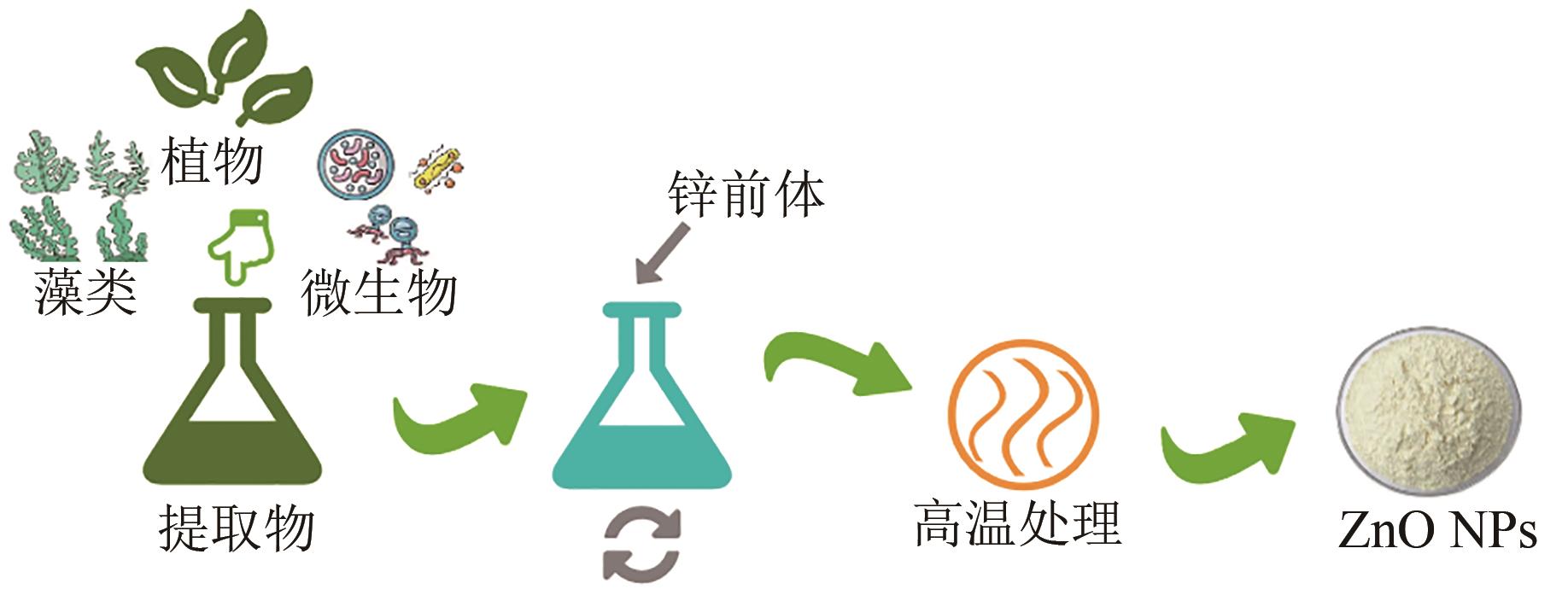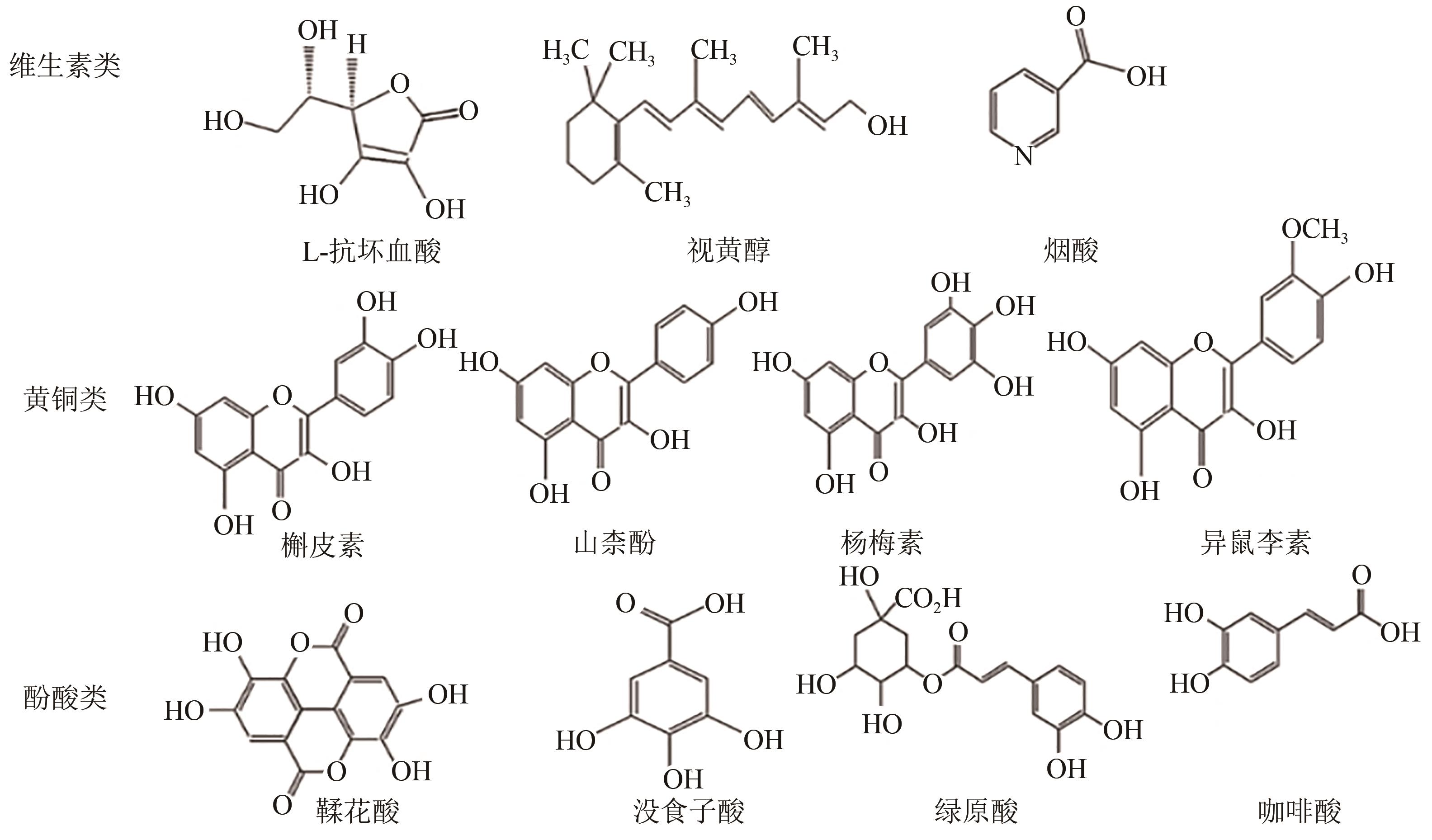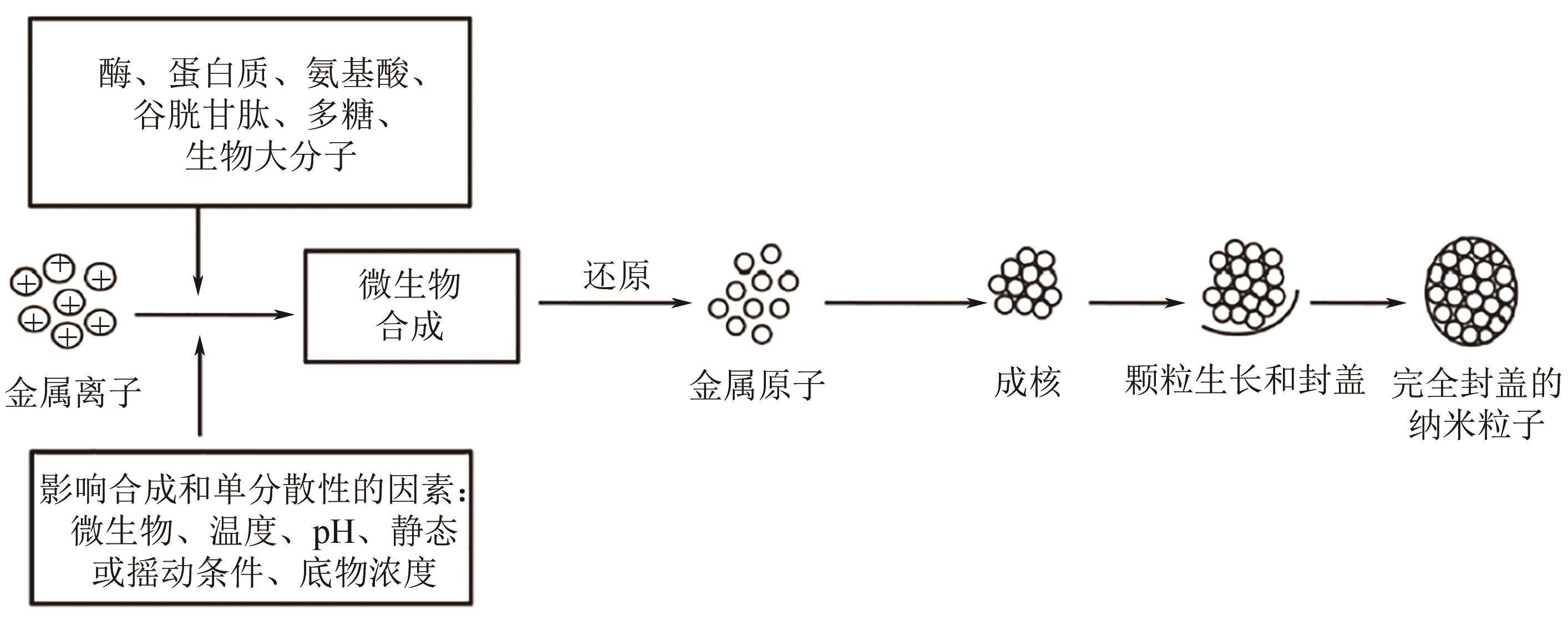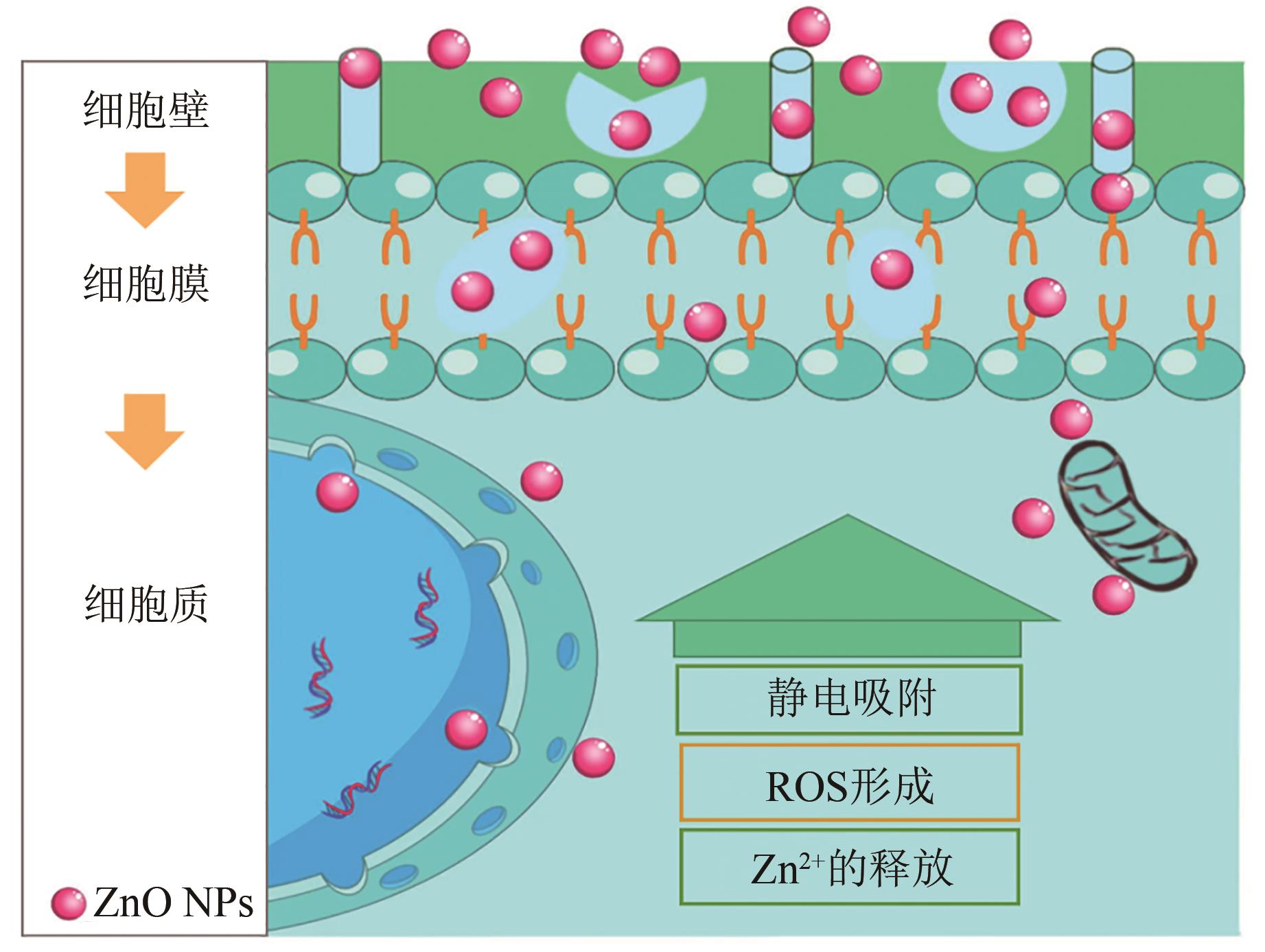化工进展 ›› 2023, Vol. 42 ›› Issue (4): 2013-2023.DOI: 10.16085/j.issn.1000-6613.2022-1026
生物合成氧化锌纳米颗粒材料及其抗菌应用
司银芳1,2,3( ), 胡语婕1,2,3, 张凡2,4, 董浩2,3,5, 佘跃惠1,2,3(
), 胡语婕1,2,3, 张凡2,4, 董浩2,3,5, 佘跃惠1,2,3( )
)
- 1.长江大学石油工程学院,湖北 武汉 430100
2.非常规油气湖北省协同创新中心,湖北 武汉 430100
3.湖北省钻采工程重点实验室,湖北 武汉 430100
4.中国地质大学(北京)能源学院,北京 100083
5.长江大学化学与环境工程学院,湖北 荆州 434023
-
收稿日期:2022-06-02修回日期:2022-08-11出版日期:2023-04-25发布日期:2023-05-08 -
通讯作者:佘跃惠 -
作者简介:司银芳(1997—),女,硕士研究生,研究方向为生物纳米材料合成与应用。E-mail:syf18829025503@163.com。 -
基金资助:国家自然科学基金重点项目(NSFC51634008);国家自然科学基金(NSFC51574038)
Biosynthesis of zinc oxide nanoparticles and its application to antibacterial
SI Yinfang1,2,3( ), HU Yujie1,2,3, ZHANG Fan2,4, DONG Hao2,3,5, SHE Yuehui1,2,3(
), HU Yujie1,2,3, ZHANG Fan2,4, DONG Hao2,3,5, SHE Yuehui1,2,3( )
)
- 1.College of Petroleum Engineering, Yangtze University, Wuhan 430100, Hubei, China
2.Hubei Cooperative Innovation Center of Unconventional Oil and Gas, Wuhan 430100, Hubei, China
3.Key Laboratory of Drilling and Production Engineering for Oil and Gas,Hubei Province,Wuhan 430100, Hubei, China
4.College of Energy, China University of Geosciences (Beijing), Beijing 100083, China
5.College of Chemistry & Environmental Engineering, Yangtze University, Jingzhou 434023, Hubei, China
-
Received:2022-06-02Revised:2022-08-11Online:2023-04-25Published:2023-05-08 -
Contact:SHE Yuehui
摘要:
随着环境污染加剧与抗生素的广泛使用,各种威胁人类健康的疾病逐渐爆发,病原菌对抗生素的耐药性问题也愈发严重。这促使许多研究都集中在对绿色环保、抗菌活性强、不易产生耐药性的新型抗菌剂的探索上,并且纳米技术已被证明可作为对抗病原菌的有效手段。氧化锌纳米颗粒材料具有优异的抗菌抑菌性能,有望作为新型金属离子抗菌材料而被广泛应用。与传统物理化学方法相比,氧化锌纳米颗粒的生物方法具有操作简单、安全性高、对环境污染小等优势,已成为纳米合成技术发展的新趋势。本文首先综述了利用植物、藻类、微生物等提取物进行氧化锌纳米颗粒的生物合成方法与合成机理,总结了氧化锌纳米颗粒的抗菌机制,讨论了氧化锌纳米材料在医药行业、纺织工业、食品行业、农业等相关领域的抗菌应用,最后进一步展望了含有氧化锌的创新型多金属复合型纳米颗粒的相关研究与应用前景,为氧化锌纳米技术发展提供了新思路。
中图分类号:
引用本文
司银芳, 胡语婕, 张凡, 董浩, 佘跃惠. 生物合成氧化锌纳米颗粒材料及其抗菌应用[J]. 化工进展, 2023, 42(4): 2013-2023.
SI Yinfang, HU Yujie, ZHANG Fan, DONG Hao, SHE Yuehui. Biosynthesis of zinc oxide nanoparticles and its application to antibacterial[J]. Chemical Industry and Engineering Progress, 2023, 42(4): 2013-2023.
| 原料 | 抑制菌种 | 粒径/nm | 应用 | 参考文献 | 年份 |
|---|---|---|---|---|---|
| 植物 | |||||
| 澳橙皮提取液、Zn(NO3)2溶液、羧甲基纤维素钠(CMC) | 灰霉菌(Botrytis cinerea)、大肠杆菌(Escherichia coli)、金黄色葡萄球菌(Staphylococcus aureus) | 33.1±11.7 | 在食品表面形成涂膜,抑制食品表面微生物的生长 | [ | 2020 |
| 辣木叶提取物、 硝酸锌氢氧化物 | 革兰氏阳性菌、革兰氏阴性菌 | 50 | 阻碍革兰氏阳性和革兰氏阴性 细菌菌株的微生物生物膜形成 | [ | 2021 |
| 百里香提取物、 二水乙酸锌溶液 | 枯草芽孢杆菌(Bacillus subtilis subsp) | 10~35 | 体外抗菌 | [ | 2021 |
| 芦荟提取物、Zn(NO3)2溶液 | 大肠杆菌 | 452 | [ | 2020 | |
| 茉莉花提取物、 葡萄糖酸锌水合物 | 大肠杆菌、屎肠球菌(Enterococcus Faecium) | 2~4 | 抗菌剂 | [ | 2016 |
| 接骨木(Sambucus ebulus) 提取物、二水乙酸锌 | 蜡样芽孢杆菌(Bacillus cereus)、 金黄色葡萄球菌、大肠杆菌 | 17 | 光催化降解亚甲基蓝染料污染物 | [ | 2020 |
| 微生物 | |||||
| 铜绿假单胞菌(P. aeruginosa)JS29、Zn(NO3)2溶液 | 金黄色葡萄球菌 | 40~50 | 药物替代品、抗菌 | [ | 2021 |
| 高耐硫酸锌的植物乳杆菌LP4、Zn(NO3)2溶液 | 9~35 | 脂肪酶的固定化 | [ | 2020 | |
| 嗜水气单胞菌(Aeromonashydrophila)、ZnO | 铜绿假单胞菌、黄曲霉 | 57.72 | 抗菌剂 | [ | 2012 |
| 地衣芽孢杆菌(Bacilluslicheniformis)、二水乙酸锌 | 620 | 光催化降解有机污染物 | [ | 2014 | |
| 烟曲霉TFR-8、Zn(NO3)2溶液 | 1.2~6.8 | 生物纳米肥料,促进莱豆生长 | [ | 2013 | |
| 藻类 | |||||
| 鞭毛藻(Dinoflagellate)、 乙酸锌溶液 | 金黄色葡萄球菌、大肠杆菌 | 20~40 | 抗菌 | [ | 2021 |
| 马尾藻(Scagassum)、 乙酸锌二水合物溶液 | 人肝癌细胞系(HepG2) | 抗血管生成和抗凋亡作用,可 作为癌症治疗的补充药物 | [ | 2018 | |
| 江蓠(Gracilaria) | 前列腺癌细胞 | 335 | 癌症治疗的补充药物 | [ | 2014 |
| 马尾藻、脱水乙酸锌溶液 | 30~57 | 生物医学和药学 | [ | 2014 | |
表1 ZnO NPs 的生物合成方法
| 原料 | 抑制菌种 | 粒径/nm | 应用 | 参考文献 | 年份 |
|---|---|---|---|---|---|
| 植物 | |||||
| 澳橙皮提取液、Zn(NO3)2溶液、羧甲基纤维素钠(CMC) | 灰霉菌(Botrytis cinerea)、大肠杆菌(Escherichia coli)、金黄色葡萄球菌(Staphylococcus aureus) | 33.1±11.7 | 在食品表面形成涂膜,抑制食品表面微生物的生长 | [ | 2020 |
| 辣木叶提取物、 硝酸锌氢氧化物 | 革兰氏阳性菌、革兰氏阴性菌 | 50 | 阻碍革兰氏阳性和革兰氏阴性 细菌菌株的微生物生物膜形成 | [ | 2021 |
| 百里香提取物、 二水乙酸锌溶液 | 枯草芽孢杆菌(Bacillus subtilis subsp) | 10~35 | 体外抗菌 | [ | 2021 |
| 芦荟提取物、Zn(NO3)2溶液 | 大肠杆菌 | 452 | [ | 2020 | |
| 茉莉花提取物、 葡萄糖酸锌水合物 | 大肠杆菌、屎肠球菌(Enterococcus Faecium) | 2~4 | 抗菌剂 | [ | 2016 |
| 接骨木(Sambucus ebulus) 提取物、二水乙酸锌 | 蜡样芽孢杆菌(Bacillus cereus)、 金黄色葡萄球菌、大肠杆菌 | 17 | 光催化降解亚甲基蓝染料污染物 | [ | 2020 |
| 微生物 | |||||
| 铜绿假单胞菌(P. aeruginosa)JS29、Zn(NO3)2溶液 | 金黄色葡萄球菌 | 40~50 | 药物替代品、抗菌 | [ | 2021 |
| 高耐硫酸锌的植物乳杆菌LP4、Zn(NO3)2溶液 | 9~35 | 脂肪酶的固定化 | [ | 2020 | |
| 嗜水气单胞菌(Aeromonashydrophila)、ZnO | 铜绿假单胞菌、黄曲霉 | 57.72 | 抗菌剂 | [ | 2012 |
| 地衣芽孢杆菌(Bacilluslicheniformis)、二水乙酸锌 | 620 | 光催化降解有机污染物 | [ | 2014 | |
| 烟曲霉TFR-8、Zn(NO3)2溶液 | 1.2~6.8 | 生物纳米肥料,促进莱豆生长 | [ | 2013 | |
| 藻类 | |||||
| 鞭毛藻(Dinoflagellate)、 乙酸锌溶液 | 金黄色葡萄球菌、大肠杆菌 | 20~40 | 抗菌 | [ | 2021 |
| 马尾藻(Scagassum)、 乙酸锌二水合物溶液 | 人肝癌细胞系(HepG2) | 抗血管生成和抗凋亡作用,可 作为癌症治疗的补充药物 | [ | 2018 | |
| 江蓠(Gracilaria) | 前列腺癌细胞 | 335 | 癌症治疗的补充药物 | [ | 2014 |
| 马尾藻、脱水乙酸锌溶液 | 30~57 | 生物医学和药学 | [ | 2014 | |
| 1 | LI Y B, XU J, WANG F, et al. Overprescribeing in China, driven by financial incentives, results in very high use of antibiotics, injections, and corticosteroids[J]. Health Affairs, 2012(31): 1075-1082. |
| 2 | WANG Z, ZHANG H, HAN J, et al. Deadly sins of antibiotic abuse in China[J]. Infection Control & Hospital Epidemiology, 2017, 38(6): 758-759. |
| 3 | KHALID A, ABDURAHMAN N, ABDULLAH A, et al. Antibacterial activity of trimetal (CuZnFe) oxide nanoparticles[J]. International Journal of Nanomedicine, 2018, 13: 77-87. |
| 4 | 麻晓霞, 马玉龙. 氧化锌型复合抗菌材料抗菌活性研究进展[J]. 功能材料, 2018, 49(9): 9061-9066. |
| MA Xiaoxia, MA Yulong. Research progress on antibacterial activity of zinc oxide composite antibacterial materials[J]. Functional Materials, 2018, 49(9): 9061-9066. | |
| 5 | LI J, SONG X, YANG T, et al. A systematic review of antibiotic prescription as sociated with upper respira- tory tract infections in China[J]. Medicine, 2016, 95(19): 3587. |
| 6 | ALRAJHI A H, AHMED N M, SHAFOURI M A, et al. Green synthesis of zinc oxide nanoparticles using salvia officials extract[J]. Materials Science in Semiconductor Processing, 2021, 125(2): 105641. |
| 7 | 刘闯, 王元贵, 耿家青, 等. 无机纳米颗粒的生物合成[J]. 化学进展, 2011, 23(12): 2510-2521. |
| LIU Chuang, WANG Yuangui, GENG Jiaqing, et al. Biosynthesis of inorganic nanoparticles[J]. Progress in Chemical, 2011, 23(12): 2510-2521. | |
| 8 | 高燕利. 纳米ZnO绿色制备及其在涂膜保鲜中的应用与锌的迁移评价[D]. 重庆: 西南大学, 2020. |
| GAO Yanli. Green synthesis of nano zinc oxide and its application in coating preservation and evaluation of Zn migration[D]. Chongqing: Southwest University, 2020. | |
| 9 | ABEL S, TESFAYE J L, NAGAPRASAD N, et al. Synthesis and characterization of zinc oxide nanoparticles using moringa leaf extract[J]. Journal of Nanomaterials, 2021, 2021: 1-6. |
| 10 | SAHIN B, AYDIN R, SOYLU S, et al. The effect of thymus syriacus plant extract on the main physical and antibacterial activities of ZnO nanoparticles synthesized by SILAR method[J]. Inorganic Chemistry Communications, 2022, 135: 109088. |
| 11 | RASLI N I, BASRI H, HARUN Z. Zinc oxide from aloe vera extract: Two-level factorial screening of biosynthesis parameters[J]. Heliyon, 2020, 6(1): e03156. |
| 12 | SHARMA D, SABELA M I, KANCHI S, et al. Biosynthesis of ZnO nanoparticles using Jacaranda mimosifolia flowers extract: Synergistic antibacterial activity and molecular simulated facet specific adsorption studies[J]. Journal of Photochemistry and Photobiology B: Biology, 2016, 162: 199-207. |
| 13 | ALAMDARI S, SASANI GHAMSARI M, LEE C, et al. Preparation and characterization of zinc oxide nanoparticles using leaf extract of Sambucus ebulus [J]. Applied Sciences, 2020, 10(10): 3620. |
| 14 | MALAKAR C, PATOWARY K, DEKA S, et al. Synthesis, characterization, and evaluation of antibacterial efficacy of rhamnolipid-coated zinc oxide nanoparticles against Staphylococcus aureus [J]. World Journal of Microbiology and Biotechnology, 2021, 37(11): 193. |
| 15 | 尹春华, 彭思雨, 马垒珍, 等. 纳米氧化锌的生物法合成及固定脂肪酶的研究[J]. 化工学报, 2020, 71(5): 2248-2255. |
| YIN Chunhua, PENG Siyu, MA Leizhen, et al. Biosynthesis of ZnO nanoparticles and their application in lipase immobilization[J]. CIESC Journal, 2020, 71(5): 2248-2255. | |
| 16 | JAYASEELAN C, RAHUMAN A A, KIRTHI A V, et al. Novel microbial route to synthesize ZnO nanoparticles using Aeromonas hydrophila and their activity against pathogenic bacteria and fungi[J]. Spectrochimica Acta Part A: Molecular and Biomolecular Spectroscopy, 2012, 90: 78-84. |
| 17 | TRIPATHI R M, BHADWAL A S, GUPTA R K, et al. ZnO nanoflowers: Novel biogenic synthesis and enhanced photocatalytic activity[J]. Journal of Photochemistry and Photobiology B: Biology, 2014, 141: 288-295. |
| 18 | RALIYA R, TARAFDAR J C. ZnO nanoparticle biosynthesis and its effect on phosphorous-mobilizing enzyme secretion and gum contents in clusterbean (Cyamopsis tetragonoloba L.)[J]. Agricultural Research, 2013, 2(1): 48-57. |
| 19 | THIRUMOORTHY G S, BALASUBRAMANIAM O, KUMARESAN P, et al. Tetraselmis indica mediated green synthesis of zinc oxide (ZnO) nanoparticles and evaluating its antibacterial, antioxidant, and hemolytic activity[J]. BioNanoScience, 2021, 11(1): 172-181. |
| 20 | SANAEIMEHR Z, JAVADI I, NAMVAR F. Antiangiogenic and antiapoptotic effects of green-synthesized zinc oxide nanoparticles using Sargassum muticum algae extraction[J]. Cancer Nanotechnology, 2018, 9(1): 3. |
| 21 | PRIYADHARSHINI R I, PRASANNARAJ G, GEETHA N, et al. Microwave-mediated extracellular synthesis of metallic silver and zinc oxide nanoparticles using macro-algae (Gracilaria edulis) extracts and its anticancer activity against human PC3 cell lines[J]. Applied Biochemistry and Biotechnology, 2014, 174(8): 2777-2790. |
| 22 | AZIZI S, AHMAD M B, NAMVAR F, et al. Green biosynthesis and characterization of zinc oxide nanoparticles using brown marine macroalga Sargassum muticum aqueous extract[J]. Materials Letters, 2014, 116: 275-277. |
| 23 | KRÓL A, POMASTOWSKI P, RAFIŃSKA K, et al. Zinc oxide nanoparticles: Synthesis, antiseptic activity and toxicity mechanism[J]. Advances in Colloid and Interface Science, 2017, 249: 37-52. |
| 24 | KHAN M M, MATUSSIN S N, RAHMAN A. Recent progress of phytogenic synthesis of ZnO, SnO2, and CeO2 nanomaterials[J]. Bioprocess and Biosystems Engineering, 2022, 45(4): 619-645. |
| 25 | IRAVANI S. Green synthesis of metal nanoparticles using plants[J]. Green Chemistry, 2011, 13(10): 2638-2650. |
| 26 | GOUR A, JAIN N K. Advances in green synthesis of nanoparticles[J]. Artificial Cells, Nanomedicine, and Biotechnology, 2019, 47(1): 844-851. |
| 27 | MANDAL D, BOLANDER M E, MUKHOPADHYAY D, et al. The use of microorganisms for the formation of metal nanoparticles and their application[J]. Applied Microbiology and Biotechnology, 2006, 69(5): 485-492. |
| 28 | SHUKLA A K, IRAVANI S. Metallic nanoparticles: Green synthesis and spectroscopic characterization[J]. Environmental Chemistry Letters, 2017, 15(2): 223-231. |
| 29 | ANU R, NISHA K, MEGHA T, et al. Leaf-extract mediated zero-valent iron for oxidation of Arsenic (Ⅲ): Preparation, characterization and kinetics[J]. Chemical Engineering Journal, 2018, 347: 91-100. |
| 30 | ALI M, KHAN T, FATIMA K, et al. Selected hepatoprotective herbal medicines: Evidence from ethnomedicinal applications, animal models, and possible mechanism of actions[J]. Phytotherapy Research, 2018, 32(2): 199-215. |
| 31 | ZHOU Y, LIN W, HUANG J, et al. Biosynthesis of gold nanoparticles by foliar broths: Roles of biocompounds and other attributes of the extracts[J]. Nanoscale Research Letters, 2010, 5(8): 1351-1359. |
| 32 | RANA A, YADAV K, JAGADEVAN S. A comprehensive review on green synthesis of nature-inspired metal nanoparticles: Mechanism, application and toxicity[J]. Journal of Cleaner Production, 2020, 272: 122880. |
| 33 | ACALYPHA Indica Linn. Biogenic synthesis of silver and gold nanoparticles and their cytotoxic effects against MDA-MB-231, human breast cancer cells[J]. Biotechnol Rep., 2014, 4: 42-49. |
| 34 | BUKHARI A, IJAZ I, GILANI E, et al. Green synthesis of metal and metal oxide nanoparticles using different plants’ parts for antimicrobial activity and anticancer activity: A review article[J]. Coatings, 2021, 11(11): 1374. |
| 35 | ZHAO X, XIA Y, LI Q, et al. Microwave-assisted synthesis of silver nanoparticles using sodium alginate and their antibacterial activity[J]. Colloids and Surfaces A: Physicochemical and Engineering Aspects, 2014, 444: 180-188. |
| 36 | BARZINJY A A, HAMAD S M, ABDULRAHMAN A F, et al. Biosynthesis, characterization and mechanism of formation of ZnO nanoparticles using petroselinum crispum leaf extract[J]. Current Organic Synthesis, 2020, 17(7): 558-566. |
| 37 | KHATANA C, KUMAR A, ALRUWAYS M W. Antibacterial potential of zinc oxide nanoparticles synthesized using aloe vera (L.) Burm. f.: A green approach to combat drug resistance[J]. J. Pure Appl. Microbiol., 2021, 15(4): 1907-1914. |
| 38 | MATINISE N, FUKU X G, KAVIYARASU K, et al. ZnO nanoparticles via Moringa oleifera green synthesis: Physical properties & mechanism of formation[J]. Applied Surface Science, 2017, 406(Jun.1): 339-347. |
| 39 | 郭慧慧, 李红卫, 韩涛, 等. 冬枣冷藏期间果皮和果肉抗氧化物质含量及其抗氧化活性的变化[J]. 林业科学, 2013, 49(1): 85-90. |
| GUO Huihui, LI Hongwei, HAN Tao, et al. Changes of active constituents and their relationship with antioxidant capacity in peel and pulp of ‘Dongzao’Jujube during storage[J]. Scientia Silvae Sinicae, 2013, 49(1): 85-90. | |
| 40 | BAKCHICHE B, HABATI M, BENMEBAREK A, et al. Total phenolic, flavonoid contents and antioxidant activities of honey and propolis collected from the region of Laghouatl (South of Algeria)[J]. World News of Natural Sciences, 2017, 1(2): 000110. |
| 41 | 冯阳阳, 赵众从, 杨文博, 等. 微生物合成金属纳米颗粒及在稠油催化降黏中的应用研究进展[J]. 化工进展, 2021, 40(4): 2215-2226. |
| FENG Yangyang, ZHAO Zhongcong, YANG Wenbo, et al. Microbial natural synthetic metal nanoparticles and the application in heavy oil catalytic viscosity reduction [J]. Chemical Industry and Engineering Progress, 2021, 40(4): 2215-2226. | |
| 42 | GHOSH S, AHMAD R, BANERJEE K, et al. Mechanistic aspects of microbe-mediated nanoparticle synthesis[J]. Frontiers in Microbiology, 2021, 12: 638068. |
| 43 | IRAVANI S. Bacteria in nanoparticle synthesis: Current status and future prospects[J]. International Scholarly Research Notices, 2014. |
| 44 | ANIL KUMAR S, ABYANEH M K, GOSAVI S W, et al. Nitrate reductase-mediated synthesis of silver nanoparticles from AgNO3 [J]. Biotechnology Letters, 2007, 29(3): 439-445. |
| 45 | VAIDYANATHAN R, GOPALRAM S, KALISHWARALAL K, et al. Enhanced silver nanoparticle synthesis by optimization of nitrate reductase activity[J]. Colloids and surfaces B: Biointerfaces, 2010, 75(1): 335-341. |
| 46 | OVAIS M, KHALIL A, AYAZ M, et al. Biosynthesis of metal nanoparticles via microbial enzymes: A mechanistic approach[J]. International Journal of Molecular Sciences, 2018, 19(12). |
| 47 | LEWISOSCAR F, VISMAYA S, ARUNKUMAR M, et al. Algal nanoparticles: Synthesis and biotechnological potentials[J]. Algae-Organisms for Imminent Biotechnology, 2016, 7: 157-182. |
| 48 | THAKKAR K N, MHATRE S S, PARIKH R Y. Biological synthesis of metallic nanoparticles[J]. Nanomedicine, 2010, 6(2): 257-262. |
| 49 | CASTRO L, BLÁZQUEZ M L, MUÑOZ J A, et al. Biological synthesis of metallic nanoparticles using algae[J]. IET Nanobiotechnology, 2013, 7(3): 109-116. |
| 50 | MATA Y N, TORRES E, BLAZQUEZ M L, et al. Gold (Ⅲ) biosorption and bioreduction with the brown alga Fucus vesiculosus [J]. Journal of Hazardous Materials, 2009, 166(2/3): 612-618. |
| 51 | 李马成, 黄勇, 李林, 等. 纳米氧化锌抑菌机理及影响因素研究进展[J]. 饲料研究, 2021, 44(6): 4. |
| LI Macheng, HUANG Yong, LI Lin, et al. Research progress on mechanisms bacteriostasis and affecting factors of nano-zinc oxide[J]. Feed Research, 2021, 44(6): 4. | |
| 52 | TRAPALIS C C, KORKAS G, KOKKORIS M, et al. Study of antibacterial composite Cu/SiO2 thin coatings[J]. Journal of Sol-gel Science and Technology, 2003, 26(1/2/3): 1213-1218 |
| 53 | 唐二军. 氧化锌/聚合物复合微粒材料的制备及抗菌特性研究[D]. 天津: 天津大学, 2005. |
| TANG Erjun. Study on zinc oxide/polymer composite particles with antibacterial property[D]. Tianjin: Tianjin University, 2005. | |
| 54 | AHMED B, AMEEN F, RIZVI A, et al. Destruction of cell topography, morphology, membrane, inhibition of respiration, biofilm formation, and bioactive molecule production by nanoparticles of Ag, ZnO, CuO, TiO2, and Al2O3 toward beneficial soil bacteria[J]. ACS Omega, 2020, 5(14): 7861-7876. |
| 55 | BRAYNER R, FERRARI-ILIOU R, BRIVOIS N, et al. Toxicological impact studies based on Escherichia coli bacteria in ultrafine ZnO nanoparticles colloidal medium[J]. Nano Letters, 2006, 6(4): 866-870. |
| 56 | SILVA B L DA, CAETANO B L, CHIARI-ANDRÉO B G, et al. Increased antibacterial activity of ZnO nanoparticles: Influence of size and surface modification[J]. Colloids and Surfaces B: Biointerfaces, 2019, 177: 440-447. |
| 57 | 孙千月, 罗雯静, 梁丹, 等. 纳米锌抗菌机理的研究进展[J]. 口腔医学研究, 2015, 31(2): 195-197. |
| SUN Qianyue, LUO Wenjing, LIANG Dan, et al. Research progress on antibacterial mechanism of nano zinc[J]. Journal of Oral Science Research, 2015, 31(2): 195-197. | |
| 58 | PASQUET J, CHEVALIER Y, COUVAL E, et al. Zinc oxide as a new antimicrobial preservative of topical products: Interactions with common formulation ingredients[J]. International Journal of Pharmaceutics, 2015, 479(1): 88-95. |
| 59 | 朱文君. ZnO抗菌性能及机理研究[D]. 成都: 西南交通大学, 2010. |
| ZHU Wenjun. Study on antibacterial properties and mechanism of ZnO[D]. Chengdu: Southwest Jiaotong University, 2010. | |
| 60 | SIRELKHATIM A, MAHMUD S, SEENI A, et al. Review on zinc oxide nanoparticles: Antibacterial activity and toxicity mechanism[J]. Nano-micro Letters, 2015, 7(3): 219-242. |
| 61 | CHO W S, DUFFIN R, HOWIE S E M, et al. Progressive severe lung injury by zinc oxide nanoparticles; the role of Zn2+ dissolution inside lysosomes[J]. Particle and Fibre Toxicology, 2011, 8(1): 1-16. |
| 62 | JIANG W, MASHAYEKHI H, XING B. Bacterial toxicity comparison between nano-and micro-scaled oxide particles[J]. Environmental Pollution, 2009, 157(5): 1619-1625. |
| 63 | RAGHUPATHI K R, KOODALI R T, MANNA A C. Size-dependent bacterial growth inhibition and mechanism of antibacterial activity of zinc oxide nanoparticles[J]. Langmuir, 2011, 27(7): 4020-4028. |
| 64 | SILVA B, ABUAFY M P, MANAIA E B, et al. Relationship between structure and antimicrobial activity of zinc oxide nanoparticles: An overview[J]. International Journal of Nanomedicine, 2019, 14: 9395-9410. |
| 65 | KHATAMI M, VARMA R S, ZAFARNIA N, et al. Applications of green synthesized Ag, ZnO and Ag/ZnO nanoparticles for making clinical antimicrobial wound-healing bandages[J]. Sustainable Chemistry and Pharmacy, 2018, 10: 9-15. |
| 66 | MOGOANT L. Biofilm-resistant nanocoatings based on ZnO nanoparticles and linalool[J]. Nanomaterials, 2021, 11(10): 2564. |
| 67 | MALIK A R, SHARIF S, SHAHEEN F, et al. Green synthesis of RGO-ZnO mediated Ocimum basilicum leaves extract nanocomposite for antioxidant, antibacterial, antidiabetic and photocatalytic activity[J]. Journal of Saudi Chemical Society, 2022, 26(2): 101438. |
| 68 | SHI L E, LI Z H, ZHENG W, et al. Synthesis, antibacterial activity, antibacterial mechanism and food applications of ZnO nanoparticles: A review[J]. Food Additives & Contaminants: Part A, 2014, 31(2): 173-186. |
| 69 | TAN L Y, SIN L T, BEE S T, et al. Funtionalization and mechanical propeties of cotton fabric with ZnO nanoparticles for antibacterial textile application[C]//Solid State Phenomena. Trans Tech Publications Ltd., 2019, 290: 292-297. |
| 70 | VERBIČ A, ŠALA M, JERMAN I, et al. Novel green in situ synthesis of ZnO nanoparticles on cotton using pomegranate peel extract[J]. Materials, 2021, 14(16): 4472. |
| 71 | SURESH S, THAMBIDURAI S, ARUMUGAM J, et al. Antibacterial activity and photocatalytic oxidative performance of zinc oxide nanorods biosynthesized using Aerva lanata leaf extract[J]. Inorganic Chemistry Communications, 2022, 139: 109398. |
| 72 | CHANG T H, LU Y C, YANG M J, et al. Multibranched flower-like ZnO particles from eco-friendly hydrothermal synthesis as green antimicrobials in agriculture[J]. Journal of Cleaner Production, 2020, 262: 121342. |
| 73 | MODI S, YADAV V K, CHOUDHARY N, et al. Onion peel waste mediated-green synthesis of zinc oxide nanoparticles and their phytotoxicity on mung bean and wheat plant growth[J]. Materials, 2022, 15(7): 2393. |
| 74 | MOHAMMADI-ALOUCHEH R, HABIBI-YANGJEH A, BAYRAMI A, et al. Green synthesis of ZnO and ZnO/CuO nanocomposites in Mentha longifolia leaf extract: Characterization and their application as anti-bacterial agents[J]. Journal of Materials Science: Materials in Electronics, 2018, 29(16): 13596-13605. |
| 75 | FAYE G, JEBESSA T, WUBALEM T. Biosynthesis, characterisation and antimicrobial activity of zinc oxide and nickel doped zinc oxide nanoparticles using Euphorbia abyssinica bark extract[J]. IET Nanobiotechnology, 2022, 16(1): 25-32. |
| 76 | JARVIN M, KUMAR S A, ROSALINE D R, et al. Remarkable sunlight-driven photocatalytic performance of Ag-doped ZnO nanoparticles prepared by green synthesis for degradation of emerging pollutants in water[J]. Environmental Science and Pollution Research, 2022, 29(38):57330-57344 |
| 77 | MEHRJO F, HASHEMI M, SOLATI Z, et al. Biosynthesis of ZnO nanosheets decorated with Pd nanoparticles and their application for electrochemical investigation of ethanol[J]. Electrocatalysis, 2021, 12(3): 272-282. |
| 78 | LEMECHO B A, SABIR F K, ANDOSHE D M, et al. Biogenic synthesis of Cu-doped ZnO photocatalyst for the removal of organic dye[J]. Bioinorganic Chemistry and Applications, 2022,2022: 8081494. |
| 79 | KHYRUN S M F, RIYAS Z M, RAJA V, et al. Environmental and biomedical applications in the synthesis and structural, optical, elemental characterizations of Mg doped ZnO nanoparticles using Coleus aromaticus leafextract[J]. South African Journal of Botany, 2022, 151: 290-300. |
| 80 | VANDEBRIEL R J, DE JONG W H. A review of mammalian toxicity of ZnO nanoparticles[J]. Nanotechnology, Science and Applications, 2012, 5: 61-71. |
| [1] | 刘宇龙, 姚俊虎, 舒闯闯, 佘跃惠. 磁性Fe3O4纳米颗粒的生物合成及其在提高采收率中的应用[J]. 化工进展, 2023, 42(5): 2464-2474. |
| [2] | 冯阳阳, 赵众从, 杨文博, 胡琳琪, 张文达, 佘跃惠. 微生物合成金属纳米颗粒及在稠油催化降黏中的应用研究进展[J]. 化工进展, 2021, 40(4): 2215-2226. |
| [3] | 仲文雅, 俞汶佳, 谷艺明, 郭静, 樊博, 蔡志强. 生物合成安丝菌素的研究进展[J]. 化工进展, 2021, 40(2): 990-997. |
| [4] | 程申, 张颂红, 贠军贤. α-酮异己酸的生物合成研究进展[J]. 化工进展, 2018, 37(12): 4821-4829. |
| [5] | 于新磊, 毛雨丰, 张晓霞, 陆凌雪, 王智文, 陈涛. 生物法生产3-羟基丙酸研究进展[J]. 化工进展, 2018, 37(11): 4427-4436. |
| [6] | 倪正, 关今韬, 沈绍传, 贠军贤. 苯乳酸的微生物合成及分离研究进展[J]. 化工进展, 2016, 35(11): 3627-3633. |
| [7] | 黄锦标1,尚龙安2. 聚羟基烷酸酯的生物合成研究进展 [J]. 化工进展, 2011, 30(9): 2041-. |
| [8] | 李金娟,赵 林,谭 欣,黄 宇,柳听义. 利用淀粉酸化废水驯化活性污泥合成聚-?-羟基脂肪酸酯及其表征 [J]. 化工进展, 2011, 30(7): 1618-. |
| [9] | 王海胜,张晓霞,卢 元,阮志勇,邢新会,姜瑞波. 紫色杆菌素研究进展 [J]. 化工进展, 2008, 27(3): 315-. |
| [10] | 李良智,芮新生,万屹东. 微生物及其酶法生产稀有L-戊糖 [J]. 化工进展, 2007, 26(5): 750-. |
| 阅读次数 | ||||||
|
全文 |
|
|||||
|
摘要 |
|
|||||




